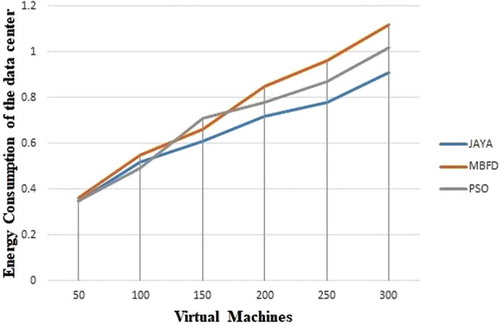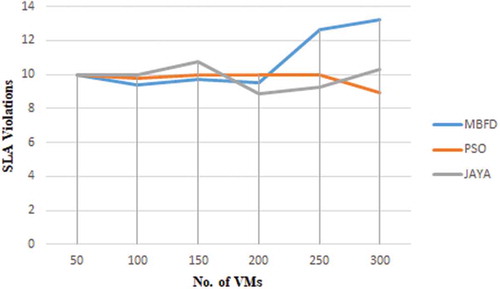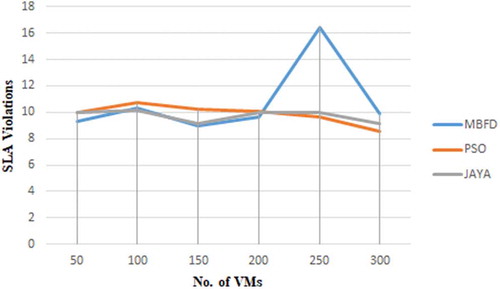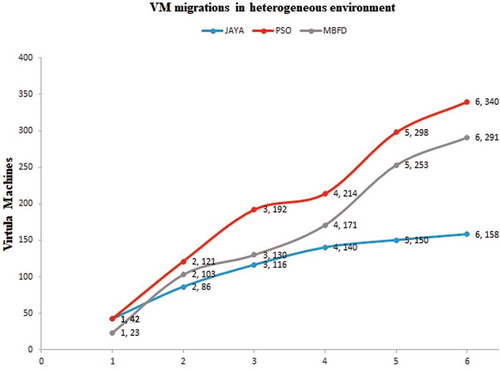 ?Mathematical formulae have been encoded as MathML and are displayed in this HTML version using MathJax in order to improve their display. Uncheck the box to turn MathJax off. This feature requires Javascript. Click on a formula to zoom.
?Mathematical formulae have been encoded as MathML and are displayed in this HTML version using MathJax in order to improve their display. Uncheck the box to turn MathJax off. This feature requires Javascript. Click on a formula to zoom.ABSTRACT
Cloud computing has become more popular with the ability to run HPC applications on cloud infrastructures. Improving the energy efficiency of these data centers become important for all the cloud providers. We observe that bin-packing heuristics such as Best-Fit Decreasing for energy-aware virtual machine (VM) allocation could not provide the optimal solution to minimize the total energy consumption of the data center. In this work, we explore the virtual machines provisioning considering multi-dimensional resources and energy consumption of the data center. We propose to use JAYA algorithm for optimal placement and minimizing the energy consumption of the data center. Our simulation results show the proposed algorithm could reduce the total energy consumption up to 34% and SLA by 15% compared with the Particle Swarm Optimization and power-aware best-fit decreasing.
Introduction
Cloud computing has been revolutionizing the IT industry, making computing and software as a utility. Cloud computing provides an extensive variety of services and applications to consumers in a pay-as-you-go model. It offers tremendous opportunities for online distribution of services using virtualized data centers. The energy consumption in the Information and communications technology (ICT) sector has increased exponentially over the last years (Shehabi et al. Citation2016). The world’s ICT infrastructure is estimated to consume 10% of global electricity usage. U.S Data centers consumed 1.4% and 1.8% of all the electricity used in U.S. in 2010 and 2014, respectively (Mills Citation2013; Van Heddeghem et al. Citation2014).
shows a graph regarding “2010 energy efficiency scenario” versus “current trends” of electricity consumption in data centers. It is forecasted that the energy consumption share of IT sector will rise up to 13% by 2030 (Reddy, Gangadharan, and Rao Citation2018) and data centers account for maximum greenhouse gas emissions on all parts of ICT (Whitehead et al. Citation2014). A survey by IBM indicates that the average resource utilization of several data centers is less than 20%. Further, 70% of power is consumed by idle servers in several data centers (Barbara et al. Citation2012; Pernici et al. Citation2012). Thus, we observe that a source of high energy consumption is not only the amount of computing resources used and power inefficiency of the hardware but also lies in the inefficient usage and dynamic power ranges of servers.
Figure 1. Datacenter energy consumption trends (Van Heddeghem et al. Citation2014).
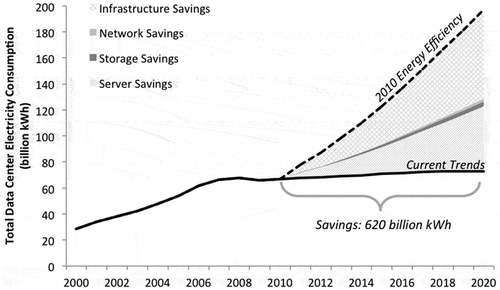
Green IT offers the use of several green metrics (Reddy et al. Citation2017) that capture efficiency and environmental characteristics. The goal is to reduce the energy consumption of servers and thermal cooling costs by efficiently utilizing the available resources (Chaudhry et al. Citation2015). This is possible with an efficient virtual machine placement mechanism to decommission unused servers. Further, migration and dynamic placement of virtual machines becomes significant for efficient data center management (Fukunaga, Hirahara, and Yoshikawa Citation2017; Garg et al. Citation2014). During the provisioning of resources to virtual machines, the resource utilization should be maximized by reducing the number of active hosts (Ricciardi et al. Citation2011). We propose and develop an efficient virtual machine provisioning mechanism to reduce the amount of energy used in a homogeneous and heterogeneous data centers.
The paper is organized as follows. Firstly, the related work on virtual machine placement and consolidation is presented in Section 2. Then, in Section 3, we proposed to use JAYA algorithm for energy efficient VM provisioning. Section 4 reports the main findings and comparison of our proposed algorithm with state-of-the-art approaches. Finally, Section 5 presents the conclusion and the future work.
Literature Review
Rapid increase in the number of internet users and the potential of video streaming applications, on-line video games, and social networking requires more data centers throughout the world. World wide data center energy consumption is estimated at 26 GW, drawing near 1.4% of world electricity consumption with a growth rate of 12% per year (I. COP21 Citation2016; Metz Citation2007). According to GeSI (Riva Citation2012), the share of total carbon dioxide (CO) emissions from ICT is estimated to grow from 1.3% of global emissions in 2002 to 2.3% in 2020. Governments are observing and analyzing the increasing energy consumption and Green House Gas (GHG) emission by IT industry. Thus, focus on improving the efficiency of the data center operations.
Garg et al. (Citation2014) considered different Quality of Service (QoS) requirements of workloads and proposed a VM provisioning approach to maximize the resource utilization and profit. Buyya et al. (Beloglazov and Buyya Citation2010) proposed an energy efficient resource provisioning in a data center using a threshold-based heuristic algorithm. Addya et al. (Citation2017) proposed a coalition-based cooperative structure to compute the pricing that users pay for their requested VMs and used Integer Linear Programming (ILP) for energy-aware virtual machine placement. Ripal et al. (Nathuji and Schwan Citation2007) proposed a Virtual Power approach with an aim to support the isolated and independent operation of virtual machines and to coordinate the effects of the diverse power management policies among the virtual machines. Implementing VPM rules are challenging in this model. This approach may reduce the server performance because of application-specific VM consolidation. Kim, Eom, and Yeom (Citation2012) described a user-level load balancer for parallel applications, considering heterogeneous architectures. This approach improves the CPU utilization and coexist with the kernel-level load balancer. Li et al. (Citation2013) proposed an approach based on a multi-dimensional space partition model for efficiently placing VMs to increase the resource utilization of data centers. However, SLA violations and VM migration cost are not taken into consideration.
Wang and Xia (Citation2016) solved VM placement problem using a mixed-integer programming approach. This approach takes more time when there are many virtual machines requests to be placed. Duan et al. (Citation2017) developed a model that considers the predictions from fractal mathematics model and schedules virtual machines using an improved ant colony algorithm. Based on load trend prediction, the model executes the scheduler while minimizing energy consumption. Wang et al. (Citation2016) proposed an improved particle swarm optimization (PSO) to place data-intensive services with minimum energy consumption and with guaranteed quality of service(QOS) in a data center. Wu, Tang, and Fraser (Citation2012) proposed an efficient VM Placement based on a Simulated Annealing (SA) approach. But this approach is not suitable for dynamic virtual machine consolidation. Goiri et al. (Citation2012) examine the multifaceted resource management considering the cost of energy consumption, SLAs, outsourcing capabilities, heterogeneity management, and economic modeling in data centers. They proposed an algorithm that tries to find those combinations from the scoring matrix that maximizes the overall system benefit. However, they confined the number of movements per round because this algorithm has a chance to enter into a periodic cycle without converging. Dong et al. (Citation2013) described the minimum cut for clustering of related VMs together to minimize the total network traffic. The algorithm helps to find the path that has a larger distance and less traffic between two virtual machines. Then, they used best-fit algorithm to reduce the energy consumption of the servers. But, this approach has not considered server overloading and network congestion.
Zhang et al. (Citation2017) developed energy-efficient VM selection algorithms for overloaded hosts based on dynamic programming and greedy algorithm. Cao and Dong (Citation2014) proposed an energy-aware heuristic framework for VM consolidation to achieve a better energy performance trade-off. Most of the researchers modeled VM consolidation as a bin packing problem and solved using greedy heuristics (Chen and Ye Citation2016; Li et al. Citation2012, Citation2013). presents the summary of the said methods, focusing on the energy consumption of the data centers.
Table 1. Summary of the literature.
Table 2. Performance of MBFD algorithm.
To overcome the said problems, we propose to minimize the total energy consumption of the data center using JAYA algorithm for energy efficient virtual machine placement in cloud data centers.
Proposed Work
Determining the optimal placement (allocation) of VMs is an essential aspect of the data center to boost the physical resource utilization to reduce the energy usage while satisfying the service level agreement (SLA). This section presents the modeling of virtual machine scheduling and proposes JAYA algorithm to solve this optimization problem in cloud data centers.
Problem Formulation
Virtual machine placement (VMP) in large data centers is a hard problem if the VM request are associated with multiple resources such as processing power, memory, storage. The VMP can be seen as a Multidimensional bin-packing problem (d-VBP) (Zhang et al. Citation2018), where each server resource is represented by a capacity in the bin and the requirements of each VM are represented as an item in the input list. The d-VBP problem is known as NP-hard for d
1 (Panigrahy et al. Citation2011).
Our aim is to derive a mapping of virtual machine to the server to maximize the resource utilization in a data center with minimum SLA violations. We consider the cpu utilization of all the servers to calculate the resource utilization of the data center. CPU utilization refers to the percentage of all the logical CPU cores in the server that is used by workloads. Our objective is to maximize the resource utilization satisfying the following constraints while allocating a virtual machine:
Each virtual machine is placed on to only one server.
A virtual machine is allocated to a server if and only if all the resource requests by the virtual machine will not exceed the available capacity of each resource in the server.
Further, we can put a upper and lower threshold on the server utilization to ensure reliability.
Notations
Let M be the number of virtual machines to be placed on to N servers in a data center. Then, we can write V as a set of virtual machines and H as a set of available servers as shown in Equations 1 and 2. and
are instances of a virtual machine and servers, respectively.
To derive a mapping of VMs (V) to the servers (H), we proposed a mapping solution (M) as follows.
where each in M represents the order of VMs to be placed onto the servers in data centers. We use the following notations in this paper:
● : indicates the
server in the set H.
● : indicates the
virtual machine in the set
.
● : Power consumption of a server
.
● A server is modeled as a five-tuple (ID, M, Cr, S, NB) where:
M is the processing capacity, ID is the identifier, Cr represents the number of cores, S is the storage capacity, and NB is network bandwidth capacity.
● A virtual machine is modeled as a four-tuple (ID, M, S, NB) where:
ID is the identifier, and M,S,and NB represents the required processing capacity, storage, and network bandwidth respectively.
● Particle Position: Let ‘m’ virtual machines are to be placed on to any of the ‘n’ heterogeneous servers in the data center. A “particle” is denoted as X and is a list of servers in a virtualized data center where it is not allowed to store duplicate values in X. Let are the virtual machine request that are to be placed on to the servers. Then, these virtual machines are packed into the servers in the order given in X.
Power Consumption Model
In this work, we use the simple server power consumption model proposed in (Reddy, Gangadharan, and Rao Citation2017). Let, be CPU utilization of the
at any given time point then the power consumption of the physical server (
) is formulated as follows:
where k = floor(10*) and
represents the power consumption of the server at k% utilization. Our aim is to decrease the total energy consumption of the servers (T) as given below.
VM Placement Using JAYA Approach
A majority of the nature-inspired algorithms with the emphasis on swarm and evolutionary computation are probabilistic in nature. The proper tuning of the algorithm-specific parameters for these approaches is an important aspect which affects the performance of a method. To overcome this problem, Rao (Citation2016) proposed JAYA algorithm without any algorithm-specific parameters. JAYA algorithm is a population-based algorithm. This algorithm updates each of the solution using best and worst solutions and makes them to reach the best solution by avoiding the worst solution. Rao et al. (Rao Citation2016; Rao, Rai, and Balic Citation2016; Zhang et al. Citation2016) reported that JAYA algorithm has shown better results than the state-of-the-art approaches.
The pseudocode for virtual machines placement with JAYA algorithm is presented in Algorithm 1. Each solution/candidate is a randomized list of servers in this case. Initially, we take the first VM request and place it on to the server which lies first in the particle data if the said conditions are satisfied. Then, the fitness for each candidate in the population is calculated according to the Equation 6. Then, we select the candidates with a minimum and maximum fitness values as the Best and Worst solutions, respectively. After each iteration, all particles are updated according to the best and worst as shown in Equation 7. This update makes the candidates to move closer to the best and avoid the worst solution. All the candidates of the population are manipulated till the target is achieved or the max-iterations are completed.
Let f(X) is the objective function, population size is n and number of design variables are m. Let B be a best candidate that has the best objective function value (minimum in our case) and W be the worst candidate that has maximum objective function value. If is a candidate during the
iteration, then it is updated for the next iteration as per the Equation 7
Algorithm 1: Optimal VM provisioning with JAYA algorithm
Input: List of servers and VMs
1 Set the parameters Max-iterations, h, and population size.
2 Initialize the population by generating a random permutation of a finite sequence (P).
3 foreach candidate population do
4 .
5 = candidate with minimum and maximum fitness values in the population.
6 repeat
7 foreach candidate population do
8 //Update each particle
9 .
10 = particle with minimum and maximum tness values in the updated population.
11 C: Store the best candidate in the population.
12 if then
13 C: Update the best candidate in the population.
14 Improve = True;
15 checkout ++;
16 if Improve == True and checkout h then
17 Return C.
18
19
20 until Max-iterations;
21 Return C.
where represent the best and worst candidates for iteration i.
is the updated value of
, and
and
are two real-valued random numbers. The term “
“ makes the candidate to reach the best candidate, and the term “
makes the current candidate to move away from the worst candidate. We keep
, if it has a better fitness value than the previous iteration. These accepted values are given as input to the next iteration. All the candidate solutions tries to move close to the best (B) by avoiding the worst (W).
Performance Evaluation
Experiment Setup
Using CloudSim (Calheiros et al. Citation2011), we generate a maximum number of 300 virtual machines and 100 servers with different configurations. There are three types of virtual machines with (30 MIPS, 613 MB RAM), (40 MIPS, 870 MB RAM), and (50 MIPS, 1740 MB RAM). The bandwidth and storage requirements of each of these virtual machines is 100 MBPS and 0.25 GB. In each simulation, we vary the number of virtual machines from 50 to 300 and the number of servers is fixe to 100. The characteristics of the servers used in our experimental are presented in .
We tested the performance our algorithm in a homogeneous and a heterogeneous environment. For a homogeneous environment, HP ProLiant ML110 Generation 4 servers are used. For heterogeneous environment, we use HP ProLiant ML110 Generation 4, IBM x3550 M3 Rack Intel Xeon X5675 and HP ProLiant ML110 Generation 5 servers. The workload is modeled to be composed of 300 task units, with each task unit requiring 432,000 million instructions (simulation of 24 min in a host with full utilization) to be executed on a host. We used Java language to implement the JAYA algorithm and simulations have been executed on a 64 bit Linux/Ubuntu operating system running on Dell Inspiron 3.5 GHz with Intel Core i7, 16 GB RAM, and 1 TB hard drive.
Results
Experiment is conducted for varying number of virtual machines in homogeneous (Env 1) and heterogeneous (Env 2) environments. For comparison and analysis, we implemented particle swarm optimization (PSO) and modified best fit decreasing (MBFD). The results are illustrated in –. Each table shows the energy consumption, SLA Violation, VM Migration and the number of hosts shutdown for the varying number of VMs in both the environments. We observed that the proposed approach reduced the number of active hosts and SLA violations.
Table 3. Performance of JAYA algorithm.
Table 4. Performance of PSO algorithm.
In the homogeneous environment with the proposed JAYA approach, we observe similar energy consumption for 50 VMs, but achieved 12%, 15%, 29%, 51%, and 82% energy savings in other cases. In a Env 2, PSO is able to reduce energy consumption upto 4% with 300 hosts. But in case of JAYA, energy savings with 150, 200, 250, and 300 VMs are 16%, 18%, 23%, and 23%, respectively.
In case of the JAYA algorithm with homogeneous hosts, the energy consumed with 150, 200, 250, and 300 VMs are 0.57, 0.61, 0.67, and 0.69 (in kWh) respectively, whereas with heterogeneous hosts the energy consumed with 150, 200, 250, and 300 VMs are 0.61, 0.72, 0.78, and 0.91 (in kWh) respectively. From , we observed that energy consumed with heterogeneous hosts using the proposed approach is less compared to MBFD and PSO with the increasing number of VMs. The number of virtual machine migrations are significantly less in case of JAYA algorithm in both cases. This proves that the proposed algorithm gives high energy savings and less VM migrations even with an increasing number of VMs.
Analysis
We analyze the performance of the proposed algorithm considering the following performance metrics:
● Total Energy consumption by the data center.
● SLA Violation: SLA violation occurs when the hosts cannot allocate the requested MIPS. It is an important measure for the negotiation of Quality of Service (QoS) between the cloud user and the cloud provider.
● VM Migrations: This gives the number of virtual machines migrated.
The average energy consumption of each algorithm in both the environments with the number of VMS varying from 50 to 300 is shown in and . In all our experiments, we use the total energy consumption in the CloudSim (kWh). Based on and , we notice that our proposed method consumes less energy compared to MBFD and PSO methods. The graph shows that data center energy consumption with PSO and MBFD approaches is much higher compared to JAYA approach that has a slight increase in energy consumption for 200, 250, and 300 VMs.
In the case of the heterogeneous environment (see ), there is not much difference in energy consumption with 50, 100, and 150 VMs. But with 200, 250, and 300 VMs the energy consumption is less in case of the JAYA algorithm. The SLA violation is also less in the case of the proposed algorithm as shown in for both the environments. There is an abrupt increase in SLA Violation (16.40%) with 250 hosts with heterogeneous hosts with MBFD approach, whereas it is very less in case of the JAYA and PSO algorithms as shown in and . Further, we notice that the number of migrations are less in most of the cases as shown in and except with 50 VMs in the case of heterogeneous hosts.
Conclusion
This paper makes research and elaboration on virtual machine provisioning strategy which is the key technology to reduce the energy consumption in a data center. This paper presents an efficient virtual machine placement in cloud data centers. We presented the mathematical model for VM placement problem. In particular, we developed JAYA algorithm for energy ware virtual machines placement. We present the detailed analysis and design of the energy aware virtual machine scheduling. The experimental results shows that the use of JAYA algorithm significantly reduce the energy consumption in a data center when compared with PSO and MBFD.
In our future work, we plan to implement the VM provisioning methods in OpenStack software, a set of open source tools for building and managing cloud computing platforms and test it in a real cloud environment. Further, we consider more advanced machine learning methods to predict resource utilization to make energy efficient resource allocation.
References
- Addya, S. K., A. K. Turuk, B. Sahoo, A. Satpathy, and M. Sarkar. 2017. A game theoretic approach to estimate fair cost of vm placement in cloud data center. IEEE Systems Journal. 12(4):3509 - 3518.
- Barbara, P., A. Marco, J. Vom Brocke, D. Brian, G. Erol, and K. Mike. 2012. What is can do for environmental sustainability: A report from caise11 panel on green and sustainable IS. Communications of Ais 30 (1):275–92.
- Beloglazov, A., and R. Buyya. 2010. Adaptive threshold-based approach for energy-efficient consolidation of virtual machines in cloud data centers. Proceedings of the 8th International Workshop on Middleware for Grids, Cloud and e-Science, MGC’10, Article No. 4, Bangalore, India.
- Beloglazov, A., and R. Buyya. 2012. Optimal online deterministic algorithms and adaptive heuristics for energy and performance efficient dynamic consolidation of virtual machines in cloud data centers. Concurrency and Computation: Practice and Experience 24 (13):1397–420. doi:10.1002/cpe.v24.13.
- Calheiros, R. N., R. Ranjan, A. Beloglazov, C. A. De Rose, and R. Buyya. 2011. Cloudsim: A toolkit for modeling and simulation of cloud computing environments and evaluation of resource provisioning algorithms. Software: Practice and Experience 41 (1):23–50.
- Cao, Z., and S. Dong. 2014. An energy-aware heuristic framework for virtual machine consolidation in cloud computing. The Journal of Supercomputing 69 (1):429–51. doi:10.1007/s11227-014-1172-3.
- Chaudhry, M. T., T. C. Ling, S. Hussain, and X.-Z. Lu. 2015. Thermal-aware relocation of servers in green data centers. Frontiers of Information Technology & Electronic Engineering 16 (2):119–34. doi:10.1631/FITEE.1400174.
- Chen, X., and D. Ye. 2016. Approximation algorithms for scheduling on multi-core processor with shared speedup resources. Discrete Optimization 20:11–22. doi:10.1016/j.disopt.2016.02.002.
- Dashti, S. E., and A. M. Rahmani. 2016. Dynamic vms placement for energy efficiency by pso in cloud computing. Journal of Experimental & Theoretical Artificial Intelligence 28 (1–2):97–112. doi:10.1080/0952813X.2015.1020519.
- Dong, J., X. Jin, H. Wang, Y. Li, P. Zhang, and S. Cheng. 2013. Energy-saving virtual machine placement in cloud data centers. Proceedings of the 13th IEEE/ACM International Symposium on Cluster, Cloud and Grid Computing (CCGrid), 618–624. IEEE, Delft, Netherlands.
- Duan, H., C. Chen, G. Min, and Y. Wu. 2017. Energy-aware scheduling of virtual machines in heterogeneous cloud computing systems. Future Generation Computer Systems 74:142–50. doi:10.1016/j.future.2016.02.016.
- Fukunaga, T., S. Hirahara, and H. Yoshikawa. 2017. Virtual machine placement for minimizing connection cost in data center networks. Discrete Optimization 26:183–98. doi:10.1016/j.disopt.2017.05.004.
- Garg, S. K., A. N. Toosi, S. K. Gopalaiyengar, and R. Buyya. 2014. Sla-based virtual machine management for heterogeneous workloads in a cloud datacenter. Journal of Network and Computer Applications 45:108–20. doi:10.1016/j.jnca.2014.07.030.
- Goiri, Í., J. L. Berral, J. O. Fitó, F. Julià, R. Nou, J. Guitart, R. Gavaldà, and J. Torres. 2012. Energy-efficient and multifaceted resource management for profit-driven virtualized data centers. Future Generation Computer Systems 28 (5):718–31. doi:10.1016/j.future.2011.12.002.
- Fatih, B. World Energy Outlook. 2016. http://www.iea.org/cop21/.
- Kim, E., H. Eom, and H. Y. Yeom. 2012. Asymmetry-aware load balancing for parallel applications in single-isa multi-core systems. Journal of Zhejiang University SCIENCE C 13 (6):413–27. doi:10.1631/jzus.C1100198.
- Kruekaew, B., and W. Kimpan. 2014. Virtual machine scheduling management on cloud computing using artificial bee colony. Proceedings of the International MultiConference of engineers and computer scientists, March 12 - 14, 2014, Hong Kong, vol. 1, 12–14.
- Li, X., Z. Qian, R. Chi, B. Zhang, and S. Lu. 2012. Balancing resource utilization for continuous virtual machine requests in clouds. Proceedings of the sixth International Conference on Innovative Mobile and Internet Services in Ubiquitous Computing (IMIS), Palermo, Italy, 266–273. IEEE.
- Li, X., Z. Qian, S. Lu, and J. Wu. 2013. Energy efficient virtual machine placement algorithm with balanced and improved resource utilization in a data center. Mathematical and Computer Modelling 58 (5–6):1222–35. doi:10.1016/j.mcm.2013.02.003.
- Metz, B., et al. 2007. Climate change 2007: Mitigation: Contribution of working group III to the fourth assessment report of the intergovernmental panel on climate change. Intergovernmental Panel on Climate Change, IPCC, Bangkok, Thailand.
- Mills, M. 2013. The cloud begins with coal-an overview of the electricity used by the global digital ecosystem. Tech. Rep, Digital Power Group, Washington D.C, USA.
- Nathuji, R., and K. Schwan. 2007. Virtualpower: Coordinated power management in virtualized enterprise systems. ACM SIGOPS Operating Systems Review 41 (6):265–78. doi:10.1145/1323293.
- Panigrahy, R., K. Talwar, L. Uyeda, and U. Wieder. 2011. Heuristics for vector bin packing, research, Microsoft reserach, https://www.microsoft.com/en-us/research/publication/heuristics-for-vector-bin-packing/.
- Pernici, B., C. Cappiello, M. G. Fugini, P. Plebani, M. Vitali, I. Salomie, T. Cioara, I. Anghel, E. Henis, R. Kat, et al. 2012. Setting energy efficiency goals in data centers: The games approach. Proceedings of the international workshop on energy efficient data centers, 1–12, Madrid, Spain, Springer.
- Rao, R. 2016. Jaya: A simple and new optimization algorithm for solving constrained and unconstrained optimization problems. International Journal of Industrial Engineering Computations 7 (1):19–34.
- Rao, R. V., D. P. Rai, and J. Balic. 2016. Surface grinding process optimization using jaya algorithm. In Computational intelligence in data mining, R.I.T., Berhampur, Odisha, India, Editors: Himansu Sekhar Behera and Durga Prasad Mohapatra, vol. 2, 487–495. Springer.
- Reddy, V. D., B. Setz, G. S. V. R. K. Rao, G. Gangadharan, and M. Aiello. 2018. Best Practices for Sustainable Datacenter, IT Professional,20(5):57-67,IEEE .
- Reddy, V. D., B. Setz, G. S. V. Rao, G. Gangadharan, and M. Aiello. 2017. Metrics for sustainable data centers. IEEE Transactions on Sustainable Computing 2 (3):290–303. doi:10.1109/TSUSC.2017.2701883.
- Ricciardi, S., D. Careglio, J. Sole-Pareta, G. Santos-Boada, U. Fiore, and F. Palmieri. 2011. Saving energy in data center infrastructures. Proceedings of the First International Conference on Data Compression, Communications and Processing (CCP), Palinuro, Italy, 265–270. IEEE.
- Riva, D. 2012. Gesi smarter 2020: The role of ICT in driving a sustainable future. wwwa.itu.int.
- Shehabi, A., S. Smith, D. Sartor, R. Brown, M. Herrlin, J. Koomey, E. Masanet, N. Horner, I. Azevedo, and W. Lintner. 2016. United states data center energy usage report., Lawrence Berkeley National Laboratory, LBNL-1005775,
- Van Heddeghem, W., S. Lambert, B. Lannoo, D. Colle, M. Pickavet, and P. Demeester. 2014. Trends in worldwide ICT electricity consumption from 2007 to 2012. Computer Communications 50:64–76. doi:10.1016/j.comcom.2014.02.008.
- Wang, S., A. Zhou, C.-H. Hsu, X. Xiao, and F. Yang. 2016. Provision of data-intensive services through energy-and QoS-aware virtual machine placement in national cloud data centers. IEEE Transaction Emerging Topics in Computing 4 (2):290–300. doi:10.1109/TETC.2015.2508383.
- Wang, Y., and Y. Xia. 2016. Energy optimal VM placement in the cloud. Proceedings of the IEEE 9th International Conference on Cloud Computing (CLOUD), San Francisco, CA, USA, 84–91. IEEE.
- Whitehead, B., D. Andrews, A. Shah, and G. Maidment. 2014. Assessing the environmental impact of data centres part 1: Background, energy use and metrics. Building and Environment 82:151–59. doi:10.1016/j.buildenv.2014.08.021.
- Wu, Y., M. Tang, and W. Fraser. 2012. A simulated annealing algorithm for energy efficient virtual machine placement. Proceedings of the IEEE International Conference on Systems, Man, and Cybernetics (SMC), COEX, Seoul, 1245–1250. IEEE.
- Zhang, A., Y. Chen, L. Chen, and G. Chen. 2018. On the np-hardness of scheduling with time restrictions. Discrete Optimization 28:54–62. doi:10.1016/j.disopt.2017.12.001.
- Zhang, K., T. Wu, S. Chen, L. Cai, and C. Peng. 2017. A new energy efficient VM scheduling algorithm for cloud computing based on dynamic programming. Proceedings of the IEEE 4th International Conference on Cyber Security and Cloud Computing (CSCloud), 26-28 June 2017, New York, USA, 249–254. IEEE.
- Zhang, Y., X. Yang, C. Cattani, R. V. Rao, S. Wang, and P. Phillips. 2016. Tea category identification using a novel fractional fourier entropy and jaya algorithm. Entropy 18 (3):77. doi:10.3390/e18030077.


